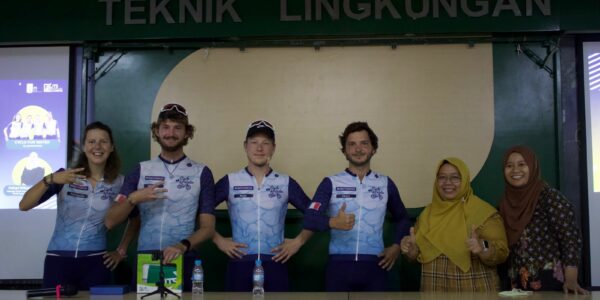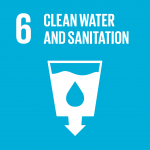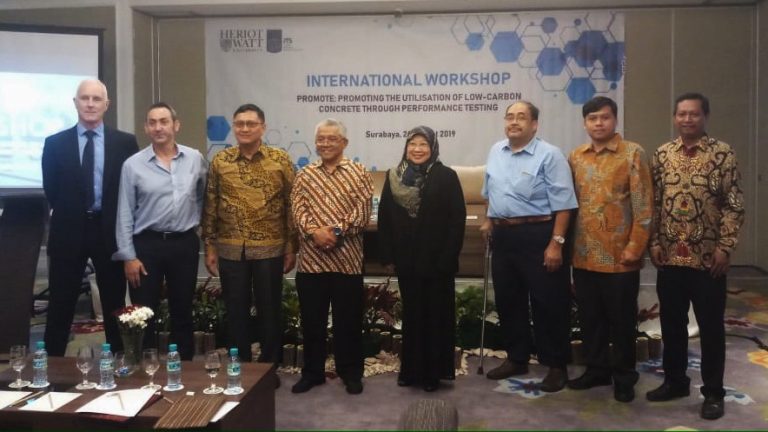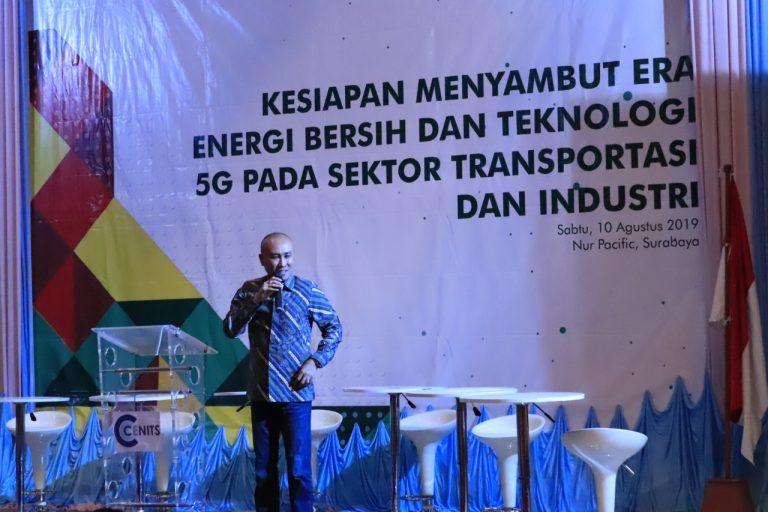“Without water we can’t live. Water supports out agriculture and aquaculture. Clean water is vital. However, due to bad economics or poor infrastructure, millions of people including children die every year from diseases associated with inadequate water supply, sanitation and hygiene.”
(THE Impact Rankings)
SDG 6: CLEAN WATER AND SANITATION
Water consumption per person
Water Consumption Monitoring and Management at Institut Teknologi Sepuluh Nopember: A Focus on Municipal Supply Usage
ITS maintains comprehensive monitoring of its water consumption, with 75% of its total water supply sourced from the Surabaya City Regional Water Supply Company (PDAM Surya Sembada). The university has implemented a strategic water monitoring system through five water gauges strategically positioned across different campus locations, including the Civil Engineering Department, Taman Alumni, Sukolilo campus, and Manyar campus. The choice of PDAM as the primary water source is particularly significant given ITS’ geographical location in a coastal area with shallow groundwater. This decision ensures reliable access to high-quality water that meets domestic consumption standards, as the local surface water quality is generally unsuitable for direct use.
The summary of PDAM water usage at the ITS campus from January to December 2023 is presented below:
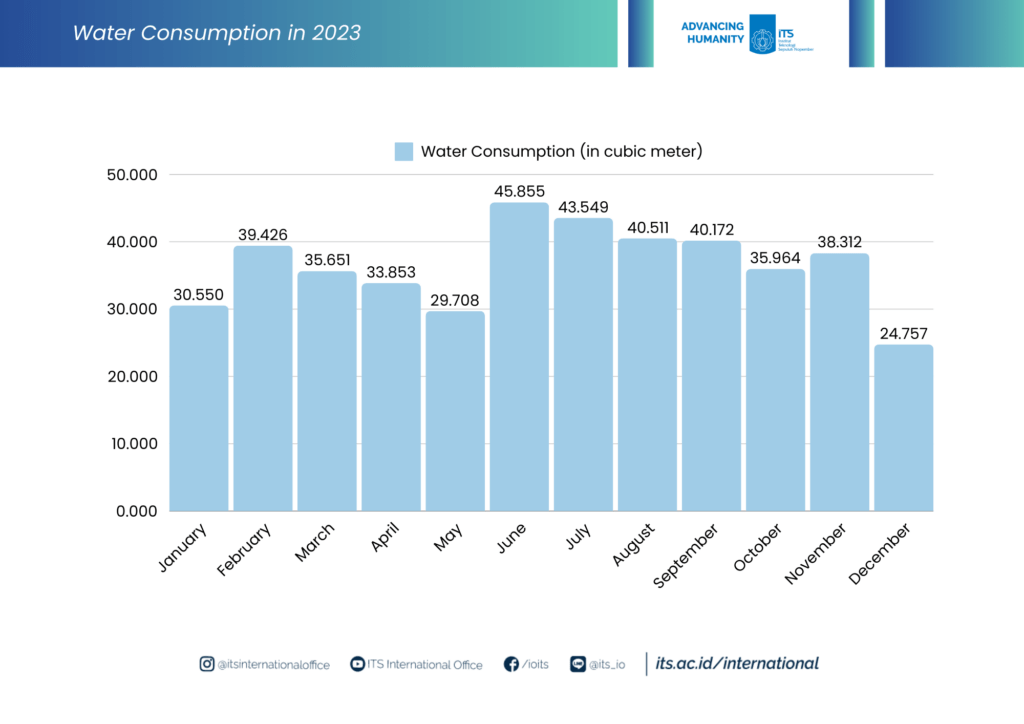
PDAM Surya Sembada Surabaya, recognized as one of Indonesia’s leading water utility companies, supplies ITS with treated water sourced from various water systems. Their comprehensive water management includes processing river water, managing reservoir systems, and regulating borehole extractions. The quality of water supplied to ITS is consistently monitored through several key parameters, including pH levels, turbidity measurements, electrical conductivity, and temperature readings. This comprehensive monitoring system allows ITS to track its water consumption patterns effectively while ensuring the water meets quality standards for university operations. The measurement data from all five gauges provides valuable insights into the institution’s water usage patterns and helps in managing water resources more efficiently.
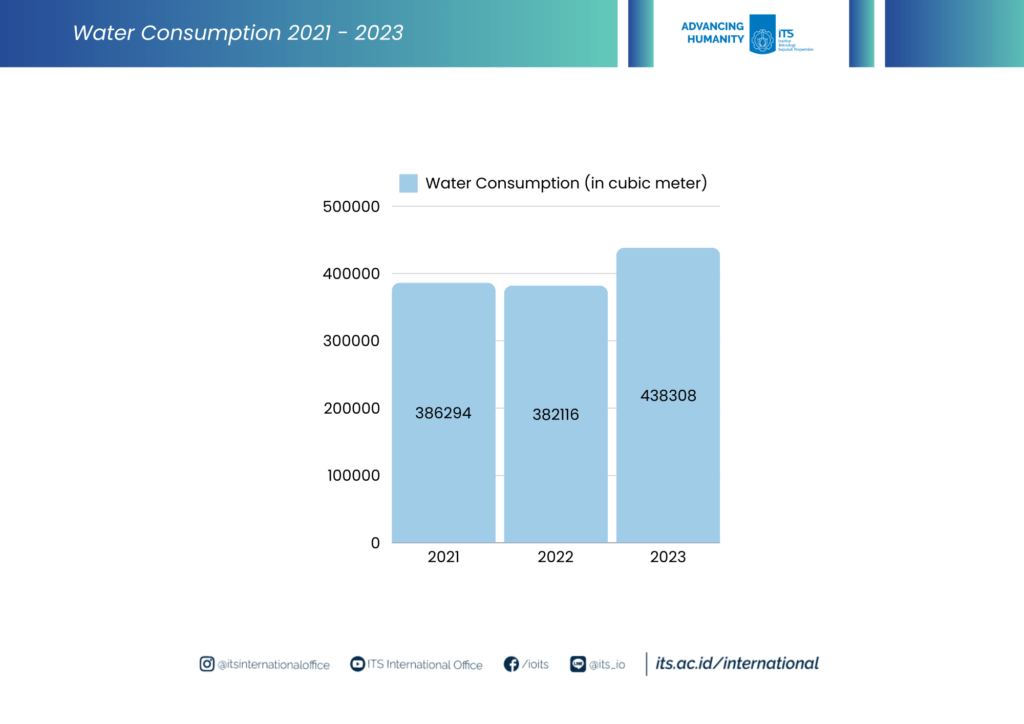
Water Usage and Care
Wastewater Treatment and Recycling Initiatives at Institut Teknologi Sepuluh Nopember: Advancing Campus Sustainability
ITS demonstrates its commitment to sustainable water management through an advanced wastewater treatment program that successfully recycles 30% of the campus’ total water needs. This comprehensive initiative operates in full compliance with regional environmental standards, specifically adhering to the Environmental Evaluation Document (DELH) and East Java Governor Regulation No. 72 of 2013, Appendix III.4, which outlines domestic wastewater quality standards.
The cornerstone of ITS’ wastewater treatment infrastructure is the Anaerobic Baffled Reactor (ABR) Wastewater Treatment Plant (WWTP), complemented by auxiliary systems including grease traps and settling ponds. This sophisticated treatment system operates under a rigorous maintenance protocol that ensures optimal performance through systematic weekly inspections of collection wells and removal of solid waste. The maintenance regime includes regular examination and repair of infrastructure components, including pipes, pumps, blowers, and electrical networks, while monthly cleaning of manhole areas prevents system blockages. To maintain high treatment standards, the facility undergoes biannual wastewater quality testing and professional desludging every two years.
The implementation of wastewater treatment facilities across campus showcases ITS’ holistic approach to water resource management. The Department of Chemistry and Environmental Engineering leads in managing laboratory-generated organic liquid waste, while the Research Center Building and Rectorate Building exemplify efficient water recycling by treating wastewater from urinals, sinks, and bathroom facilities for toilet flushing purposes. Religious facilities such as the Manarul Ilmi Mosque and the Department of Mechanical Engineering demonstrate innovative water reuse by directing treated ablution water to landscape irrigation and fish pond maintenance. The central canteen’s dedicated liquid waste management system further completes the campus-wide treatment network.
Wastewater Programs Implementation at ITS
Currently, ITS recycles 30% of its water, which is within the range of >25 – 50% water recycled. ITS has established formal policies for water recycling programs, which include the use of recycled water for various purposes. The specific programs implemented are:
a. Using recycled water from ablution and gray water from the Manarul Ilmi mosque toilets as a resource for fishponds and plant watering,
b. Recycling ablution water to water plants in various departments, including Department of Mechanical Engineering, Industrial Engineering, Marine Engineering, and Material and Metallurgy Engineering,
c. Reutilizing wastewater for toilet flushing at the Research Center, Science Tower, and ITS Rectorate,
d. Optimally utilizing treated gray water from constructed wetlands in the Department of Environmental Engineering These comprehensive programs highlight ITS’s commitment to water conservation and sustainable practices.
By implementing these initiatives, ITS is not only reducing its environmental footprint, but also cultivating a culture of sustainability within the campus community.
1. Using recycled water from ablution and gray water from the Manarul Ilmi mosque toilets as a resource for fishponds and plant watering
Water is recycled through a holding pond and aeration process, allowing it to be reused for watering plants with sprinklers and as raw water for fishponds.
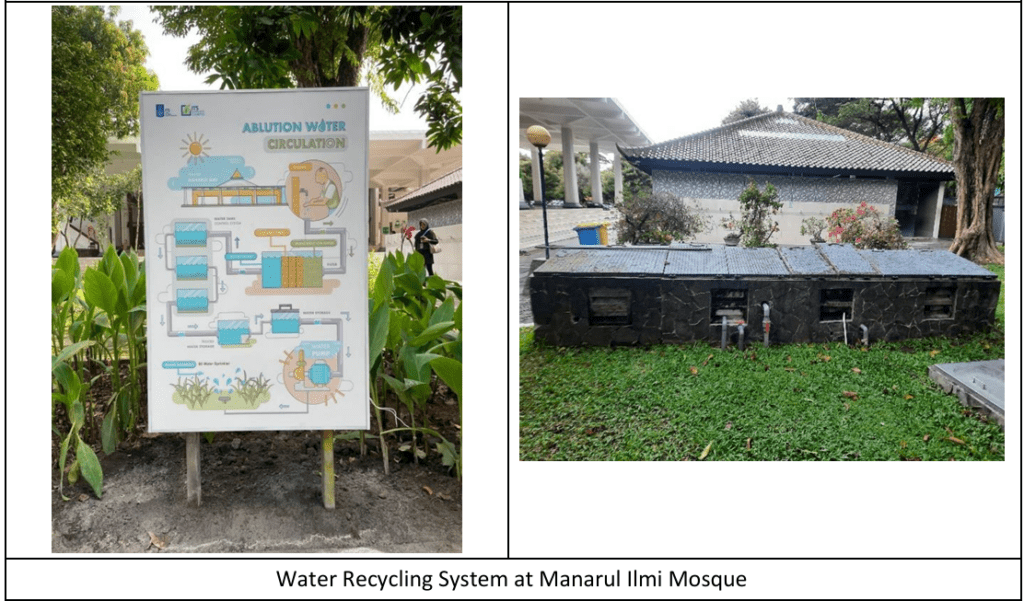
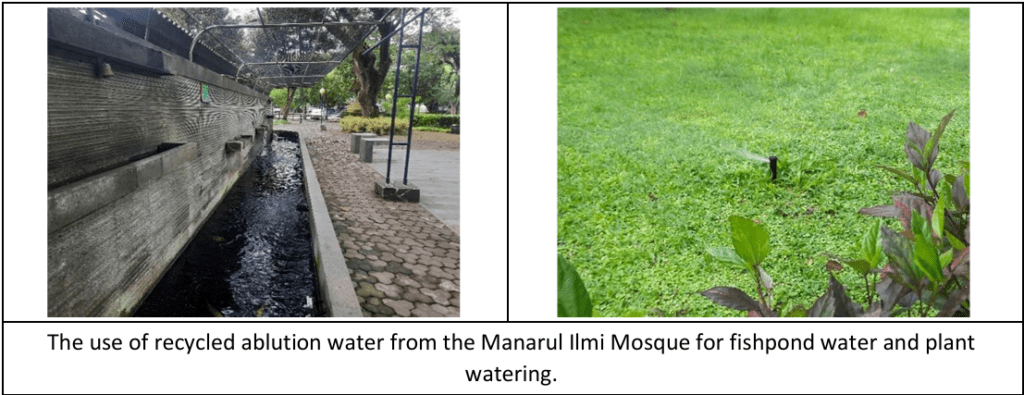
2. Recycling ablution water to water plants in various departments
The water used for ablution in Mechanical Engineering, Industrial Engineering, and Material and Metallurgy Engineering is collected in a holding pond and reused for plant watering.
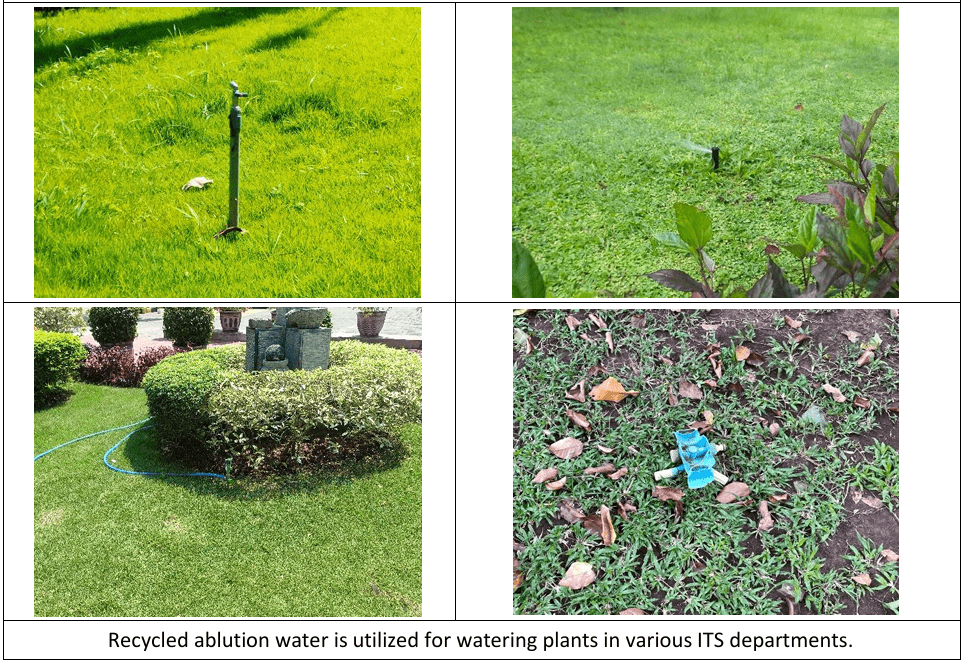
3. Reutilizing wastewater for toilet flushing at the Research Center
Wastewater from the urinal, sink, and floor drain in the ITS Research Center Buildings’s restroom is treated through a wastewater treatment plant (WWTP) and repurposed for flushing toilets.
4. Reutilizing wastewater for toilet flushing at the ITS Rectorate
Wastewater from the urinal, sink, and floor drain in the ITS Rectorate Buildings’s restroom is treated through a wastewater treatment plant (WWTP) and repurposed for flushing toilets.
5. Optimally utilizing treated gray water from constructed wetlands in the Department of Environmental Engineering
The Environmental Engineering department effectively recycles grey water by collecting it in constructed wetlands. The treated water is then utilized for watering the plants.
Sewage Disposal Management
The wastewater disposal methods at the Sepuluh Nopember Institute of Technology (ITS) are technically handled for down-cycling, including:
- Wastewater treatment at ITS is carried out through the Wastewater Treatment Plant (IPAL) that is reused as irrigation water for plants or as flushing water for toilets.
- The clean toilet program is one of the flagship programs of the Rector of ITS to improve the quality of environmental sanitation on the ITS campus.
The Rector’s Circular Letter Number T/95007/IT2/TU.00.08/2019 promotes the wastewater disposal program on the ITS campus, specifically:
A. Efforts to improve environmental sanitation
- Conducting a campaign to enhance toilet cleanliness on campus;
- Encouraging water conservation efforts by avoiding unnecessary water usage and promoting the reuse of wastewater for irrigation activities;
- Promoting domestic wastewater management efforts through treatment and recycling efforts.
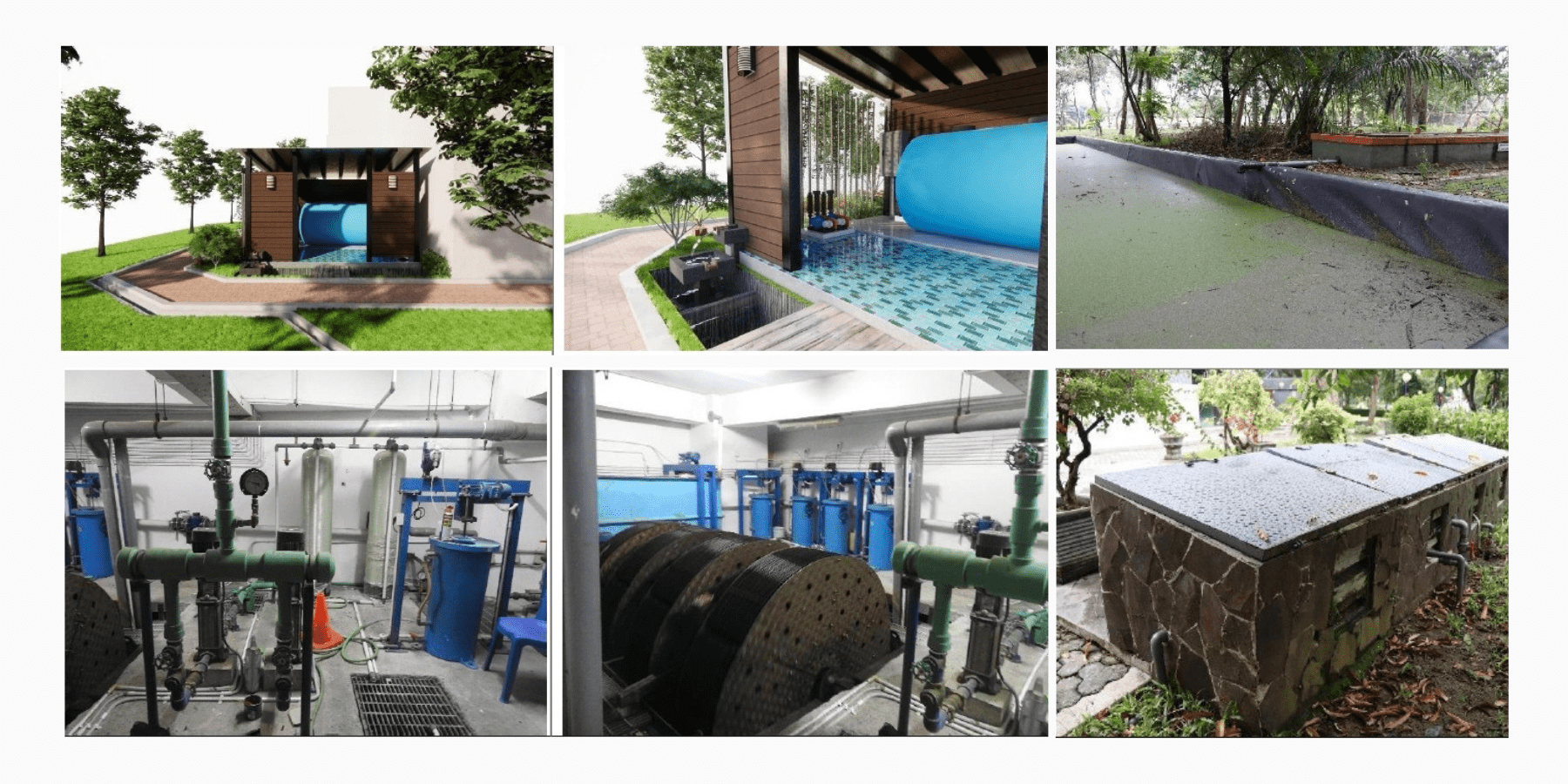
Wastewater treatment at ITS is conducted through the Anaerobic Baffled Reactor (ABR) Wastewater Treatment Plant (IPAL) or a simple Waste Treatment Facility using grease traps and settling ponds. Some IPAL locations at ITS include:
- Wastewater from urinals, sinks, and floor drains in the Rectorate building is treated through the IPAL and reused for toilet flushing water.
- Wastewater from urinals, sinks, and floor drains in the ITS Research Center building is treated through the IPAL and reused for toilet flushing water.
- Organic wastewater from laboratory activities is managed at the IPAL in the Department of Chemistry and the Department of Environmental Engineering.
- Used ablution water at Manarul Ilmi Mosque ITS is managed with a collection and aeration pond and reused for watering plants and as raw water for fish ponds.
- Used ablution water in the Department of Mechanical Engineering is collected in a holding pond and reused for watering plants.
- Wastewater sourced from the central canteen is treated using the ABR IPAL located behind the central canteen of ITS.
Water Recycling Program Implementation
Currently, ITS recycles 30% of its water, which is within the range of >25 – 50% water recycled. ITS has established formal policies for water recycling programs, which include the use of recycled water for various purposes. The specific programs implemented are:
a. Using recycled water from ablution and gray water from the Manarul Ilmi mosque toilets as a resource for fishponds and plant watering,
b. Recycling ablution water to water plants in various departments, including Department of Mechanical Engineering, Industrial Engineering, Marine Engineering, and Material and Metallurgy Engineering,
c. Reutilizing wastewater for toilet flushing at the Research Center, Science Tower, and ITS Rectorate,
d. Optimally utilizing treated gray water from constructed wetlands in the Department of Environmental Engineering
These comprehensive programs highlight ITS’s commitment to water conservation and sustainable practices. By implementing these initiatives, ITS is not only reducing its environmental footprint, but also cultivating a culture of sustainability within the campus community.
1. Using recycled water from ablution and gray water from the Manarul Ilmi mosque toilets as a resource for fishponds and plant watering
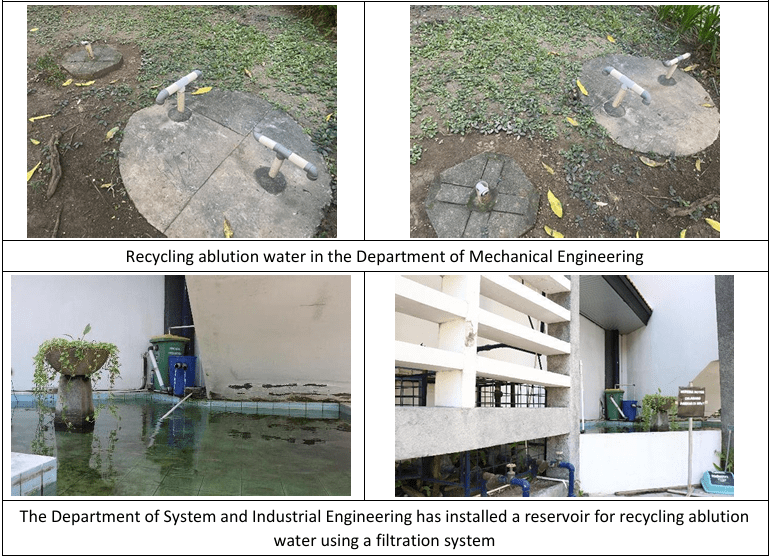
2. Recycling ablution water to water plants in various departments
3. Reutilizing wastewater for toilet flushing at the Research Center
4. Reutilizing wastewater for toilet flushing at the ITS Rectorate
5. Optimally utilizing treated gray water from constructed wetlands in the Department of Environmental Engineering
Water Pollution Prevention and Management Systems at Institut Teknologi Sepuluh Nopember
ITS has implemented a robust, multi-layered approach to water pollution prevention and management, governed by strict institutional policies and regional regulations. This comprehensive system is designed to protect water resources while ensuring sustainable campus operations, as mandated by the Rector’s Circular Letter No. T-95007-IT2-TU.00.08-2019 and aligned with East Java Governor Regulation No. 72 of 2013, Appendix III.4.
The institution’s pollution prevention strategy operates through two main channels:
- Advanced Wastewater Treatment Infrastructure:
- The primary defense against water pollution is the Anaerobic Baffled Reactor (ABR) Wastewater Treatment Plant (WWTP), which employs a sophisticated combination of physical, chemical, and biological processes to remove contaminants and harmful substances from wastewater.
- Supporting systems include strategically placed grease traps and sedimentation ponds, providing additional layers of protection against pollutants entering the water system.
- This infrastructure is installed across key campus locations, including the Rectorate Building, Research Center, Manarul Ilmi Mosque, Central Canteen, and various academic departments (Chemistry, Environmental Engineering, and Mechanical Engineering).
2. Hazardous and Toxic Waste (B3) Management System:
- A comprehensive protocol handles 50-75% of potentially harmful substances separately from regular waste streams.
- Specialized management procedures for different types of hazardous materials, particularly from high-risk areas such as Chemical Engineering, Environmental Engineering, Chemistry, Materials, Biology, and Mechanical Engineering laboratories.
- Strict protocols for medical waste storage using designated containers and freezers.
- Secure storage systems for academic-related hazardous materials in appropriate laboratory containers and jerrycans.
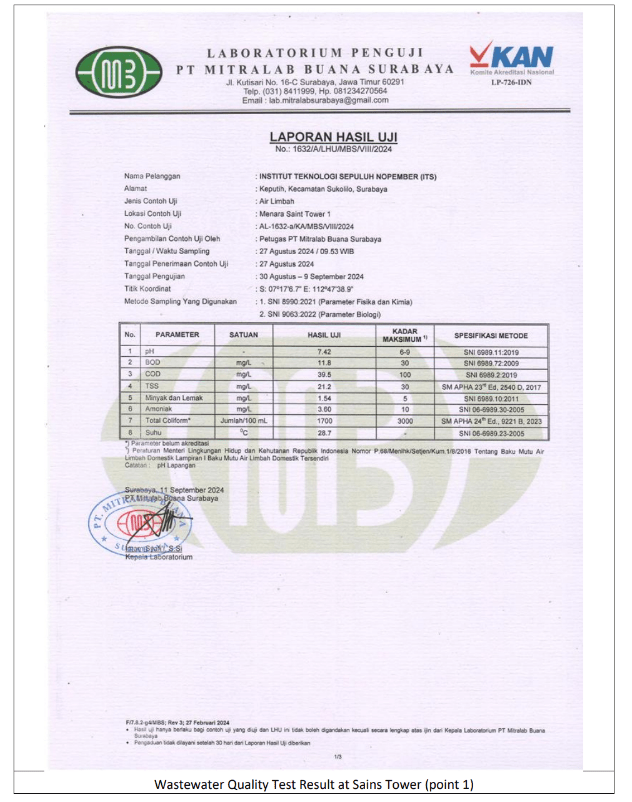
To ensure the effectiveness of these systems, ITS maintains a rigorous maintenance schedule:
- Weekly inspections of collection wells and removal of floating debris
- Regular assessment and maintenance of all system components, including pipes, pumps, blowers, and electrical networks
- Monthly cleaning of manhole areas to prevent system overflows
- Biannual laboratory testing of wastewater samples to verify treatment effectiveness
- Professional desludging services every two years
Emergency Response and Incident Prevention:
- Clear protocols for handling accidental spills or releases
- Partnership with certified third-party providers for proper disposal of hazardous materials
- Regular monitoring and maintenance to prevent system failures
- Dedicated storage and containment systems to prevent accidental releases
ITS also has an environmental permit that encompasses all campus activities, issued under the Decree of the Head of the Surabaya Environmental Service 2021. This decree addresses the environmental feasibility of office buildings, lectures, and supporting facilities at ITS, including Science Technopark/STP Development, and the Culture and Language Center, located in the Keputih, Sukolilo, Surabaya. This document stipulates the need for environmental management and monitoring on the ITS campus, which includes:
A. Water quality monitoring result
- Regular monitoring results of wastewater quality at Sains Tower 1.
- Regular monitoring results of wastewater quality at the Rectorate Building.
- Regular monitoring results of wastewater quality at Tower 2 Building.
B. ITS Environmental Eligibility Permit
- Decree from the Head of the Surabaya Environmental Service concerning Environmental Feasibility at ITS
- Map of ITS’s environmental monitoring and management efforts
Through this comprehensive approach to water pollution prevention, ITS demonstrates its commitment to protecting water resources and maintaining environmental quality. The system not only prevents pollution from routine campus activities but also provides robust protection against accidental contamination, ensuring the safety and sustainability of the campus water system. This integrated approach to water resource protection serves as a model for other educational institutions in implementing effective environmental management practices.
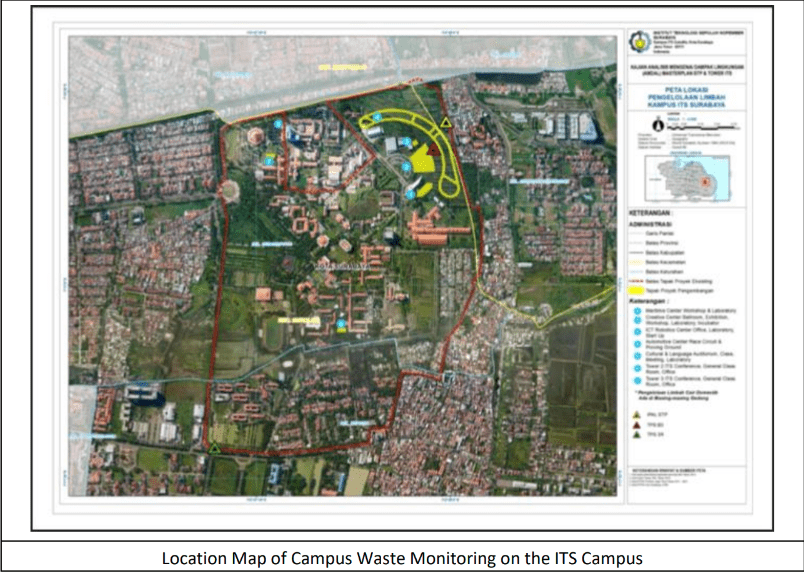
Currently, ITS recycles 30% of its water, which is within the range of >25 – 50% water recycled. ITS has established formal policies for water recycling programs, which include the use of recycled water for various purposes. The specific programs implemented are:
- Using recycled water from ablution and gray water from the Manarul Ilmi mosque toilets as a resource for fishponds and plant watering,
- Recycling ablution water to water plants in various departments, including Department of Mechanical Engineering, Industrial Engineering, Marine Engineering, and Material and Metallurgy
Engineering,- Reutilizing wastewater for toilet flushing at the Research Center, Science Tower, and ITS Rectorate,
- Optimally utilizing treated gray water from constructed wetlands in the Department of Environmental Engineering
- These comprehensive programs highlight ITS’s commitment to water conservation and sustainable
practices.By implementing these initiatives, ITS is not only reducing its environmental footprint, but also cultivating a culture of sustainability within the campus community
Free and Accessible Drinking Water Initiative at Institut Teknologi Sepuluh Nopember
ITS has established a comprehensive free drinking water program through its Drinking Water Facilities (KASM) initiative, demonstrating the institution’s commitment to both community welfare and environmental sustainability. Access Points and Availability: The KASM program features strategically placed drinking water stations across the campus, ensuring convenient access for the entire campus community. These stations are thoughtfully distributed at key locations including:
Manarul Ilmi Mosque Plaza Angka parking area Department of Mechanical Engineering Department of Physics Engineering Department of Materials and Metallurgical Engineering
In addition to these KASM stations, ITS provides extensive access to free drinking water through electric water dispensers installed in all department and unit buildings across campus. These dispensers ensure that students, faculty, staff, and visitors can easily obtain clean drinking water wherever they are within the academic premises.

In addition to these KASM stations, ITS provides extensive access to free drinking water through electric water dispensers installed in all department and unit buildings across campus. These dispensers ensure that students, faculty, staff, and visitors can easily obtain clean drinking water wherever they are within the academic premises.
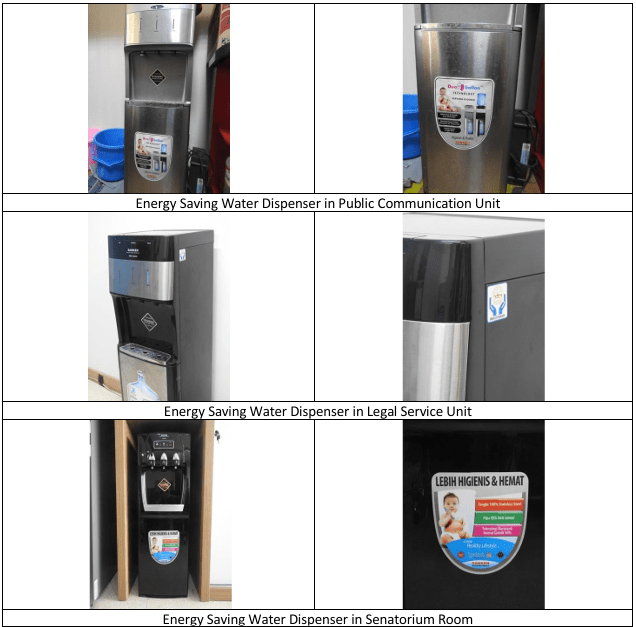
Key Benefits of the KASM Program and Building Dispensers:
- Universal Access:
- Available 24/7 for students, staff, and visitors
- Completely free of charge
- No restrictions on usage
- Accessible locations throughout the campus
- Convenient water dispensers in every department and unit building
- Environmental Impact:
- Significant reduction in single-use plastic bottles
- Decreased campus waste from disposable water containers
- Promotion of sustainable drinking water practices
- Encouragement of reusable water bottle usage
- Community Benefits:
- Eliminates financial barriers to accessing clean drinking water
- Supports student well-being by ensuring hydration
- Promotes a more inclusive campus environment
- Convenient access during academic activities and campus events
- Multiple access points through both KASM stations and building dispensers ensure maximum coverage and convenience
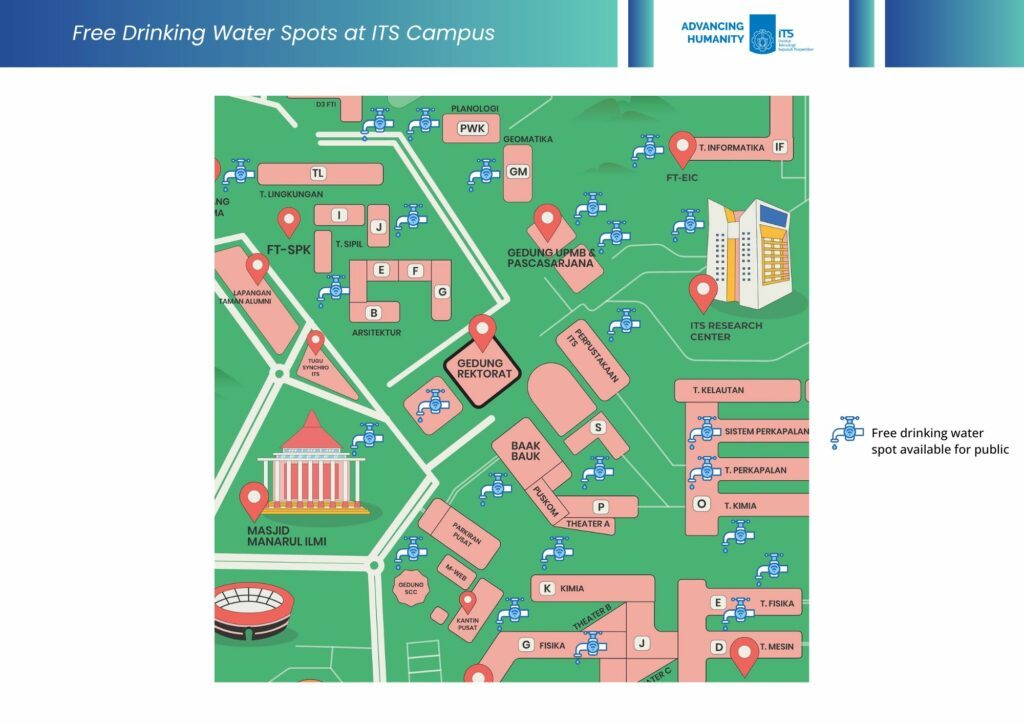
This initiative represents ITS’ approach to community welfare, combining environmental responsibility with social inclusivity. By providing free, accessible drinking water through both KASM stations and building dispensers, ITS ensures that every member of the campus community has unrestricted access to this essential resource while simultaneously contributing to campus sustainability goals through the reduction of plastic waste.
Water-Conscious Building Standards at Institut Teknologi Sepuluh Nopember: A Model for Sustainable Water Management
ITS has established comprehensive water-conscious building standards that exemplify modern sustainable water management practices. These standards, successfully implemented across campus facilities including the Manyar campus, incorporate innovative technologies and design elements to minimize water consumption while maximizing water efficiency. At the heart of ITS’ water management strategy is an advanced rainwater harvesting system, integrated throughout multiple campus buildings. This system effectively collects and stores rainwater, significantly reducing the campus’s dependence on municipal water supplies while providing a sustainable source for non-potable water uses. The implementation of these harvesting systems demonstrates ITS’s commitment to effective water resource management and sets a standard for sustainable building practices.
The institution has also made significant strides in implementing water-efficient fixtures and technologies across more than half of its campus facilities. Some examples are (but not limited to):
1. Installation of Automatic Faucets: The implementation of handwashing taps aims to optimize water efficiency, with both manual
and sensor-activated taps installed in wash basins. Modern automatic hand-washing taps prevent excessive water usage.
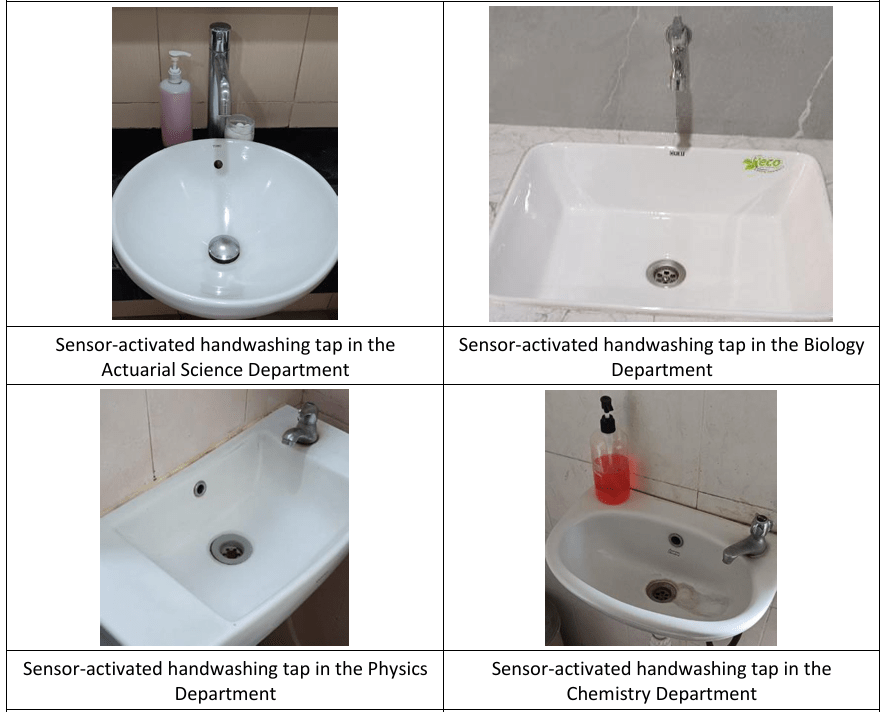
2. Treatment of Contaminated Water and: Water pollution control on campus involves treating wastewater generated by residents, including lecturers, staff, students, and visitors. This wastewater consists of domestic waste and wastewater from laboratory and clinical activities. Wastewater treatment from each activity at ITS is carried out through the Anaerobic Baffled Reactor (ABR) Wastewater Treatment Plant (WWTP) or a simple one using grease traps and settling ponds.
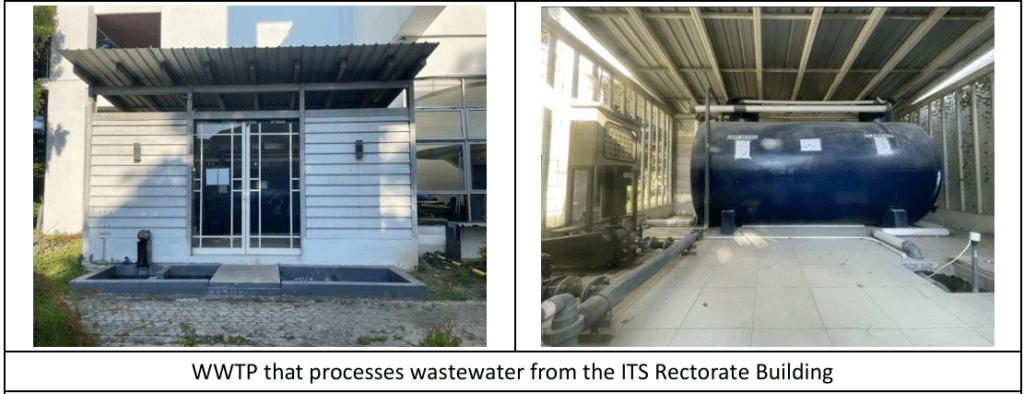
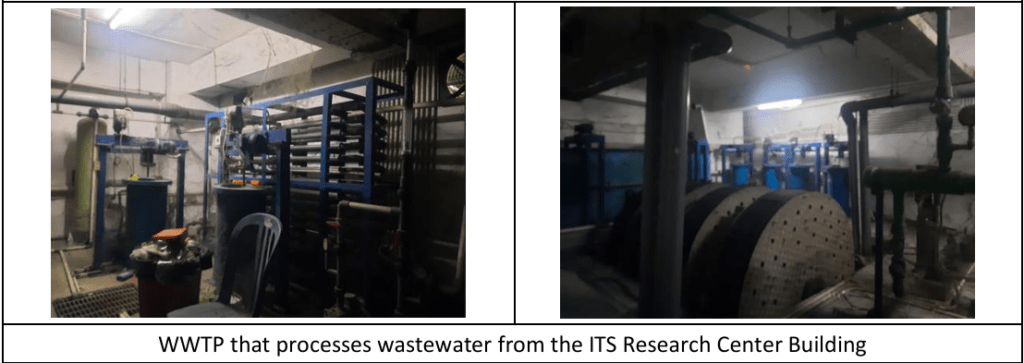
3. Rainwater Harvesting: ITS has implemented water catchment holes, or biopores, to effectively and efficiently absorb rainwater. These biopores are strategically located in various areas on campus, including the Urban and Regional Planning Department, Mechanical Engineering, Industrial Engineering, UPMB Buildings, SAC, and the Robotika ITS facility. By installing these biopores, ITS enhances groundwater recharge, reduces surface runoff, and promotes sustainable water management practices. This initiative not only helps in mitigating flood risks but also supports the campus’s overall environmental sustainability goals. (foto diambil dari [4.1] Water Conservation Program and Implementation)
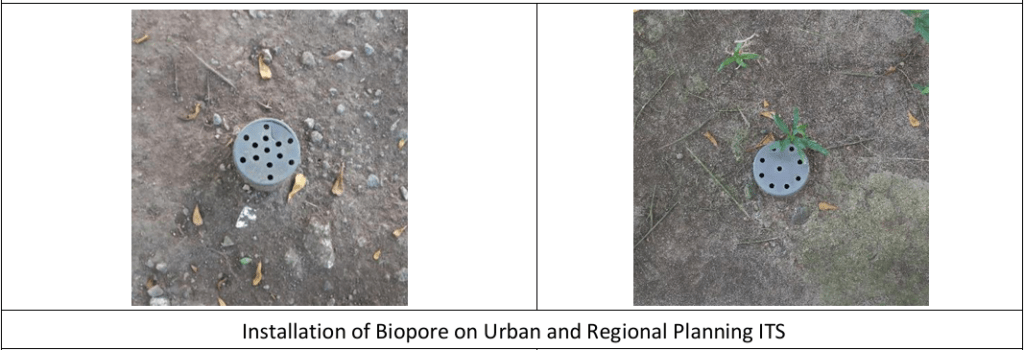
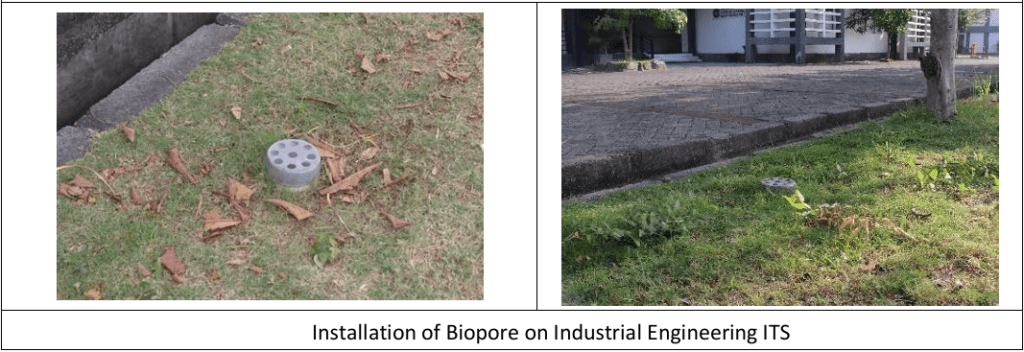
Water recycling and reuse form another crucial component of ITS’ water-conscious building standards. The institution has implemented comprehensive wastewater recycling systems that enable the repurposing of treated water for appropriate applications. This approach not only reduces overall water consumption but also maximizes the efficiency of water use across campus facilities. Through these comprehensive building standards, ITS demonstrates its unwavering commitment to sustainable water management. The impact is evident in the significant reduction of potable water consumption, enhanced water conservation practices, and improved groundwater management across the campus. These initiatives collectively promote a culture of environmental responsibility within the campus community while setting an exemplary model for other institutions to follow.
Water-Conscious Landscape Design at ITS: A Showcase of Drought-Resistant Plant Species
ITS demonstrates its commitment to water conservation through strategic landscape design, featuring an array of drought-resistant plants across its campus. These carefully selected species create visually appealing green spaces while minimizing water consumption, particularly during dry seasons. The campus’s water-conscious landscape includes these key drought-tolerant species:
1. Handroanthus chrysotrichus (Tabebuia):
This golden-flowered tree stands as the most extensively planted species across campus, gracing numerous significant locations including the Department of Global Kampoeng, Engineering Physics, the Rectorate, Library, and various administrative buildings. Its widespread presence demonstrates how drought-resistant species can create impressive landscapes with minimal water requirements.2. Bougainvillea:
Strategically planted throughout the U block lecturer housing, these vibrant flowering plants provide colorful displays while requiring minimal irrigation, exemplifying how residential areas can maintain aesthetic appeal with water-efficient landscaping.3. Arecaceae (Palm):
These majestic palms line the ITS Highways and Civil Engineering Department, offering shade and architectural interest while being naturally adapted to survive with limited water resources.4. Melaleuca citrina (Crimson Bottlebrush):
Featured prominently at the Department of Global Engagement, this Australian native brings brilliant red blooms while demonstrating remarkable drought tolerance.

5. Casuarina equisetifolia L. (Coastal She-oak):
Found at both the Department of Global Engagement and Department of Chemistry, this hardy tree thrives in challenging conditions while requiring minimal water maintenance.
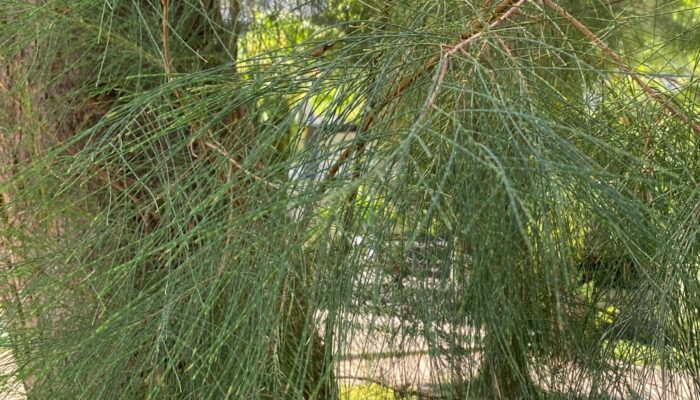
6. Mimusops elengi (Spanish cherry):
Adorning the Central Administration Office, this species combines ornamental value with natural water efficiency.

7. Aloe vera and Sansevieria (Snake plant):
These succulent species, showcased at the Department of Global Engagement, exemplify how water-storing plants can create attractive landscapes while consuming minimal water resources.8.Cycas revoluta (Sago Palm):
Positioned at ITS Tower 2, this distinctive palm-like plant demonstrates how architectural plants can be both striking and water-efficient.
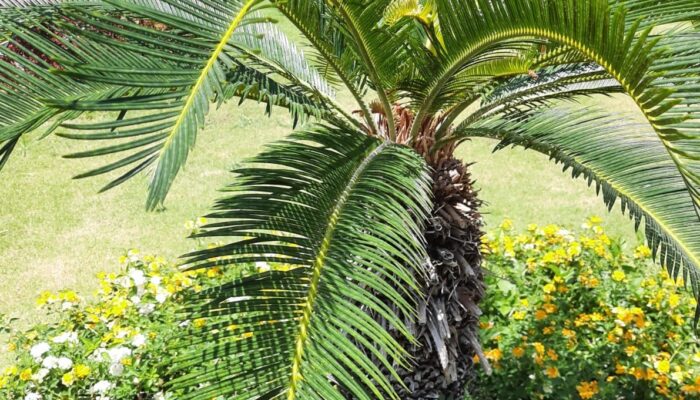
Through this thoughtful selection of drought-resistant plants, ITS has created a sustainable landscape model that successfully balances aesthetic appeal with water conservation principles. This approach not only reduces water consumption but also educates the campus community about the possibility of creating beautiful, water-efficient green spaces in institutional settings.
Water reuse
ITS Implements Comprehensive Water Reuse Policy: Advancing Sustainable Water Management in Campus Operations
ITS has established a comprehensive framework for water management that places significant emphasis on water reuse and conservation. Through Rector Circular Letter to ITS’ Commitment as a Green and Sustainable Campus, the university demonstrates a forward-thinking approach to water sustainability, implementing both direct and indirect water reuse strategies across campus operations. The key water reuse policies can be summarized into two main categories:
- Direct Water Reuse Initiatives:
a. Wastewater treatment and recycling
b. Reuse of recycled water for:
1. Plant irrigation
2. Toilet flushing
3. General cleaning purposes- Indirect Water Reuse/Conservation Measures:
a. Rainwater harvesting as an alternative water source
b. Optimization of retention ponds for:
1. Rainwater storage
2. Flood control on campus
- Implementation of water-saving technology in campus facilities
The policy shows that ITS has made water reuse a priority in its sustainability efforts, though the implementation details are somewhat general rather than highly specific. The approach appears to be comprehensive in scope but could benefit from more detailed operational guidelines and specific targets.
While the policy framework demonstrates clear dedication to sustainable water management, there are areas that could benefit from further development. The current policy would be strengthened by the inclusion of specific targets and metrics for water reuse, detailed technical standards for water treatment, and comprehensive monitoring procedures. ITS’ water reuse policies reflect a strong commitment to environmental sustainability. The university’s approach to water management aligns with modern sustainability practices, creating a foundation for responsible water use within an academic setting. This comprehensive strategy not only addresses immediate water conservation needs but also positions ITS as an institution committed to environmental stewardship.
Water Conservation Program and Implementation
ITS has implemented a systematic and formalized program that supports water conservation, achieving more than 50% water conservation. The specific initiatives include:
1. Lake and pond management systems for rainwater storage
2. Long storage channel surrounding the ITS Sukolilo campus
3. Wetland area conservation
4. Installation of biopores to increase the quantity of groundwater
5. Elevated buildings at ITS for rainwater storage
6. Rainwater harvestingBy implementing these measures, ITS not only conserves water but also promotes sustainable water management practices.
1. ITS has lakes and ponds that are managed and functioned as water conservation areas and open areas.
ITS has 18 lakes and ponds, including detention and retention ponds, designed to manage rainwater on campus.
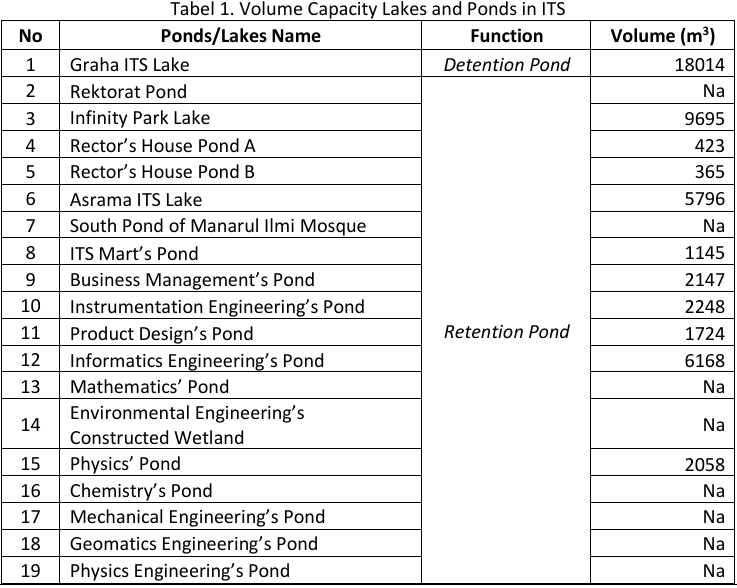
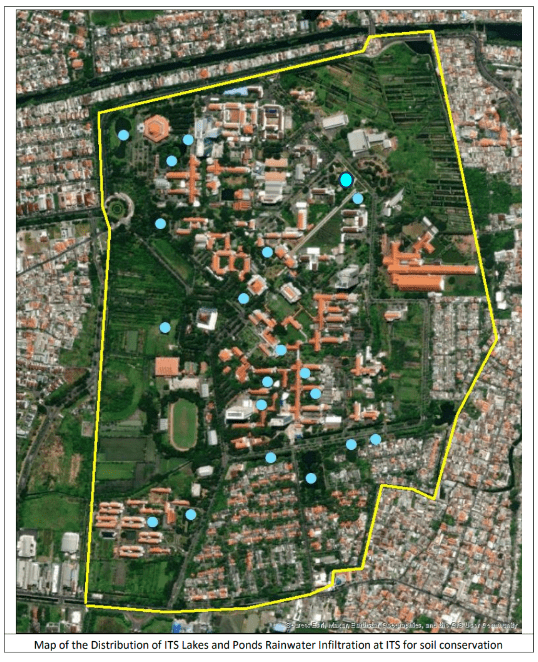
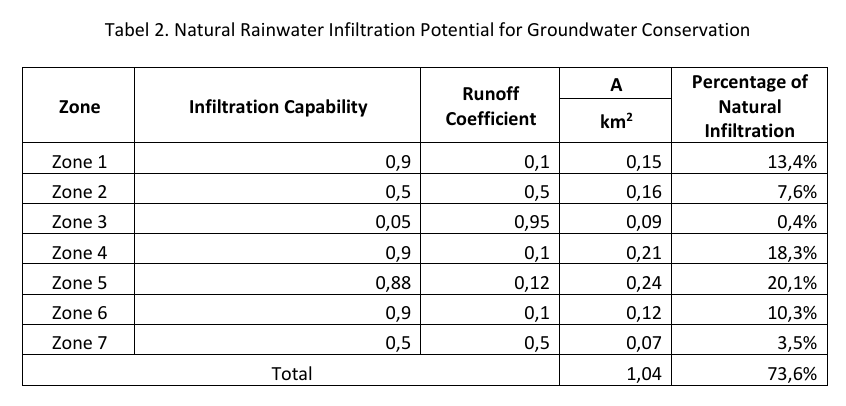
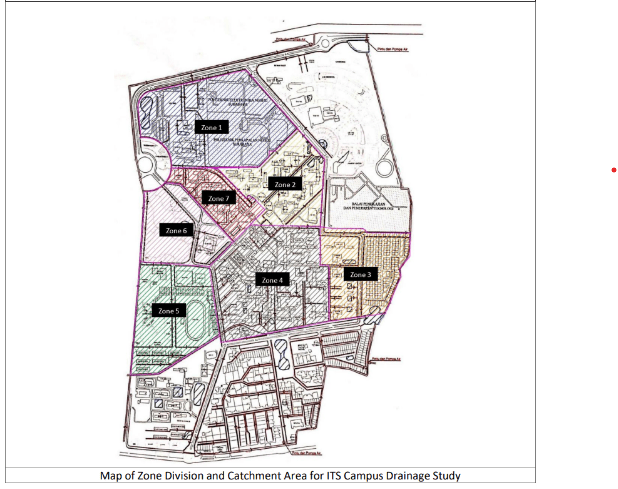
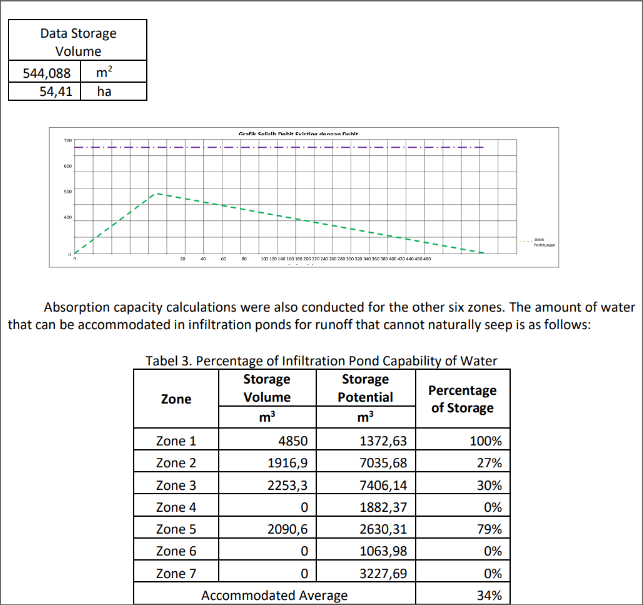
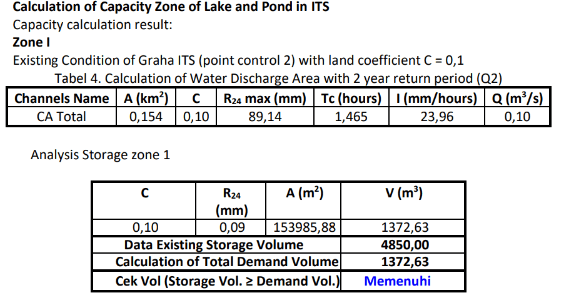
The total water that can be conserved naturally is
= Percentage of water that seeps naturally + percentage of runoff water that can be accommodated
= 73,6% + 34% x (100% – 73,6%)
= 73,6% + 8,96%
= 82,51%
2. Long Storage Channel ITS
ITS has a long storage channel surrounding the campus, measuring up to 470 meters in length and 6 meters in width. This channel plays a critical role in managing water flow, assisting with flood prevention, and enhancing water conservation efforts on campus.3. Wet Land Area Conservation
ITS has a substantial wetland area, covering approximately 29,6 hectares and constituting about 16% of the campus. These wetlands are actively utilized by the local community for cultivating aquatic plants like water spinach and pandanus. This not only supports local agriculture but also enhances the ecological value of the campus by promoting biodiversity and sustainable land use practices.
4. Installation of Biopore on ITS
ITS has implemented water catchment holes, or biopores, to effectively and efficiently absorb rainwater. These biopores are strategically located in various areas on campus, including the Urban and Regional Planning Department, Mechanical Engineering, Industrial Engineering, UPMB Buildings, SAC, and the Robotika ITS facility. By installing these biopores, ITS enhances groundwater recharge, reduces surface runoff, and promotes sustainable water management practices. This initiative not only helps in mitigating flood risks but also supports the campus’s overall environmental sustainability goals.5. ITS has elevated structure on a building
The elevated structure is designed to preserve the functionality of water recharge areas, allowing rainwater to flow through it. This type of structure can be observed in nearly all buildings at ITS, including those in the Mechanical Engineering, Electrical Engineering, Chemical Engineering, Visual Communication Design, Urban and Regional Planning, and Physics Departments. By incorporating these elevated structures, ITS not only enhances its water management capabilities but also demonstrates a commitment to sustainable building practices. These efforts contribute to reducing surface runoff, mitigating flood risks, and promoting a greener, more resilient campus environment.
6. ITS developed water conservation programs through rainwater harvesting on urban farming ITS
The rainwater harvesting buildings at ITS are ingeniously designed to efficiently collect and store rainwater. This sustainable practice not only conserves water but also plays a crucial role in supporting the development of urban farming initiatives in the open areas across the campus. By utilizing harvested rainwater, these buildings contribute to creating a greener, more self-sufficient environment for the university community.
Water in the community
Bridging Education and Community Needs Through Water Management Projects
ITS demonstrates its commitment to water management education through Community Service Programs (KKN) that blend academic expertise with practical community solutions. These educational initiatives serve a dual purpose: providing hands-on learning experiences for ITS students while educating local communities about sustainable water management practices. In Setrohadi Village, Chemistry Department students have taken a leading role in water management education. Through practical demonstrations, they have taught community members essential water treatment processes, including aeration and filtration techniques. The program has equipped residents with knowledge about water quality standards and testing methods, along with hands-on training in operating and maintaining water treatment systems.
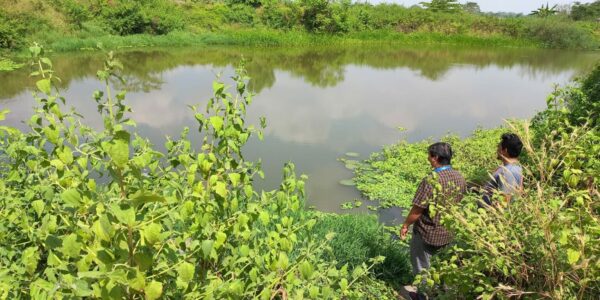
The Mantren Village initiative, led by the Environmental Engineering team, has established a robust educational framework focused on water infrastructure maintenance. The program has successfully facilitated the formation and training of local maintenance groups (pokmas), while also educating residents about proper hygiene practices and handwashing techniques. Additionally, the community has gained valuable insights into sustainable water resource management principles. In Tanjungsari Village, the Industrial Chemical Engineering department has made significant strides in community education. Through comprehensive workshops, they have taught residents about water quality assessment and trained them in filtration system operation. The program has also covered crucial aspects of water distribution management and provided essential knowledge about water testing and safety standards.
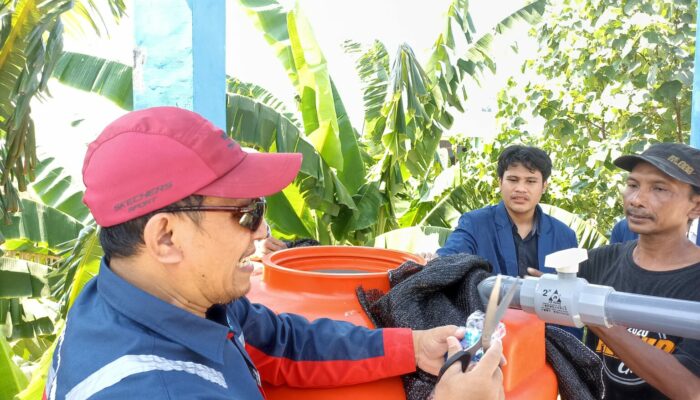
These educational programs share common elements that contribute to their success. They emphasize practical, hands-on learning experiences and foster deep community engagement in water management. The initiatives focus on sustainable maintenance practices and facilitate long-term knowledge transfer, ultimately building local capacity for water resource management.
ITS Supports Water Conservation through Technological Innovation
ITS extends water conservation support beyond the campus area through innovative technological solutions, demonstrating its unwavering commitment to addressing environmental challenges in Indonesian communities. Through its Community Service Program (KKN) and Community Engagement (Abmas) initiatives, the institution has successfully implemented various water management solutions that are transforming lives across different regions.
In a project in Setrohadi Village, Duduk Sampeyan District, Gresik Regency, an ITS KKN team comprising 19 Chemistry Department students has achieved a breakthrough in water treatment technology. The team tackled the challenge of converting unusable lake water, which was initially brackish, turbid, greenish, and malodorous, into clean, usable water. Their solution involved developing a sophisticated reactor utilizing an upflow aeration and filtration system. This innovative water treatment system incorporates multiple filtration stages, including rapid sand filters, manganese filters, zeolite filters, activated carbon filters, and paranet nets. The success of this system largely relies on the strategic use of silica sand and carbon, where silica sand effectively removes solids and impurities, while carbon serves as an efficient absorbent for various contaminants.
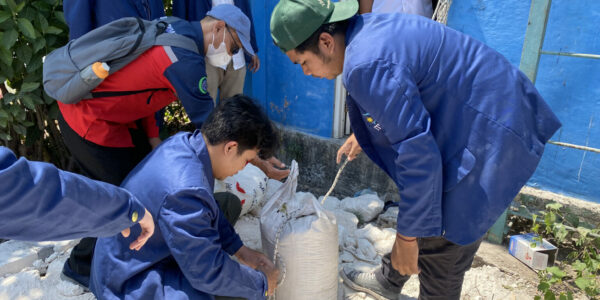
Simultaneously, in Mojosari Village, Mojokerto, another groundbreaking initiative has emerged from the ITS Abmas team. Responding to government restrictions on diesel fuel usage, they developed an innovative agricultural irrigation solution: a solar-powered water pump system integrated with Internet of Things (IoT) technology. This advanced system harnesses solar energy through panels, converting sunlight into electrical power stored in batteries. What makes this system particularly revolutionary is its IoT dashboard feature, enabling farmers to monitor and control pump operations remotely through the thingsboard.com website, significantly improving irrigation management efficiency.
The impact of these innovations has been profound and far-reaching. In Gresik, the community now enjoys access to clean, potable water, fundamentally improving their quality of life. The Mojokerto farmers have experienced substantial benefits too, with the new irrigation system helping them save valuable time, energy, and operational costs in managing their agricultural water needs.
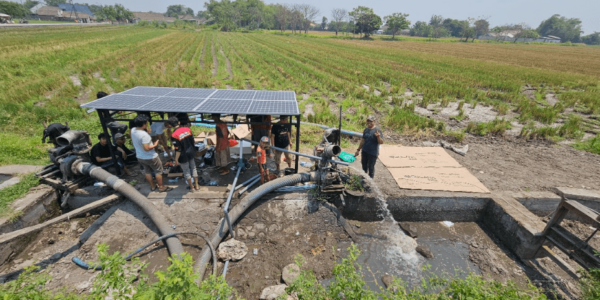
This comprehensive approach to water conservation exemplifies how academic institutions can effectively contribute to solving real-world environmental challenges through practical technological applications. The success of these projects not only highlights ITS’s commitment to environmental sustainability but also demonstrates the powerful impact that can be achieved when academic knowledge is applied to address community needs. Through these initiatives, ITS continues to pave the way for sustainable water management practices while fostering a culture of innovation and environmental responsibility in Indonesia.
Full article:
Abmas ITS Gagas Pompa Air Berbasis PLTS dan IoT untuk Irigasi
Sustainable Water Management: ITS’ Comprehensive Approach to Water Extraction and Conservation
ITS has implemented a comprehensive water management system that demonstrates its commitment to sustainable water extraction and conservation across campus grounds. The university’s approach encompasses multiple integrated systems and technologies that ensure efficient water utilization while maintaining ecological balance. At the heart of ITS’ water infrastructure is an extensive network of 18 water bodies, strategically categorized into detention and retention ponds, with lakes and reservoirs organized across seven distinct zones. This infrastructure serves as the primary source of water extraction, with a total capacity of 1,372.63 m3, successfully meeting the campus’s water demands. The management of these water bodies is carefully planned to maintain natural conservation through controlled infiltration and runoff water processes.
The university employs several innovative sustainable water extraction technologies throughout its campus. The lake and reservoir management systems form the backbone of this infrastructure, with systematic management of the 18 ponds providing reliable water sources across the campus grounds. These water bodies are thoughtfully divided into detention and retention ponds, organized across seven operational zones to optimize water distribution and management efficiency.
A distinctive feature of ITS’ water management approach is the implementation of elevated building structures across most campus buildings. This architectural design serves a dual purpose: storing rainwater while maintaining the natural water catchment functionality of the area. The elevated structure ensures smooth water flow management, contributing to the overall efficiency of the water system.
The rainwater harvesting system represents another crucial component of ITS’s water management strategy, primarily supporting the university’s urban farming initiatives. This system significantly reduces dependency on conventional water sources while integrating seamlessly with sustainable agriculture practices on campus. Complementing this is an extensive network of biopore installations strategically placed across multiple locations, including the Department of Urban and Regional Planning, Department of Mechanical Engineering, Department of Industrial Engineering, UPMB Building, SAC, and ITS Robotic Center.
Surrounding the campus, a long storage channel system extends approximately 470 meters with a width of 6 meters, effectively encircling the ITS grounds. This channel system enhances water retention and distribution capabilities, forming an integral part of the campus’s water management infrastructure. ITS further enhances its water management through innovative recycling systems. The university has implemented a comprehensive gray water recycling program that processes used water from ablution facilities and bathrooms. Dedicated installation units treat this water, which is then repurposed for irrigation and fishponds. This recycling system has been successfully implemented in several key locations across campus, including the Manarul Ilmi Mosque, Department of Mechanical Engineering, and Industrial Engineering Department.
The success of ITS’ water management system is evidenced by the implementation of over 50 percent of its planned water conservation program. This comprehensive approach not only ensures sustainable water extraction but also promotes water efficiency across all campus operations. Through these integrated systems, ITS demonstrates how educational institutions can effectively manage water resources while maintaining ecological responsibility and promoting sustainability.
Water Conservation Program at ITS
ITS has implemented a systematic and formalized program that supports water conservation, achieving
more than 50% water conservation. The specific initiatives include:1. Lake and pond management systems for rainwater storage
2. Long storage channel surrounding the ITS Sukolilo campus
3. Wetland area conservation
4. Installation of biopores to increase the quantity of groundwater
5. Elevated buildings at ITS for rainwater storage
6. Rainwater harvestingBy implementing these measures, ITS not only conserves water but also promotes sustainable water management practices.
1. ITS has lakes and ponds that are managed and functioned as water conservation areas and open areas.
ITS has 18 lakes and ponds, including detention and retention ponds, designed to manage rainwater on campus.


The total water that can be conserved naturally is
= Percentage of water that seeps naturally + percentage of runoff water that can be accommodated
= 73,6% + 34% x (100% – 73,6%)
= 73,6% + 8,96%
= 82,51%
2. Long Storage Channel ITS
ITS has a long storage channel surrounding the campus, measuring up to 470 meters in length and 6 meters in width. This channel plays a critical role in managing water flow, assisting with flood prevention, and enhancing water conservation efforts on campus.
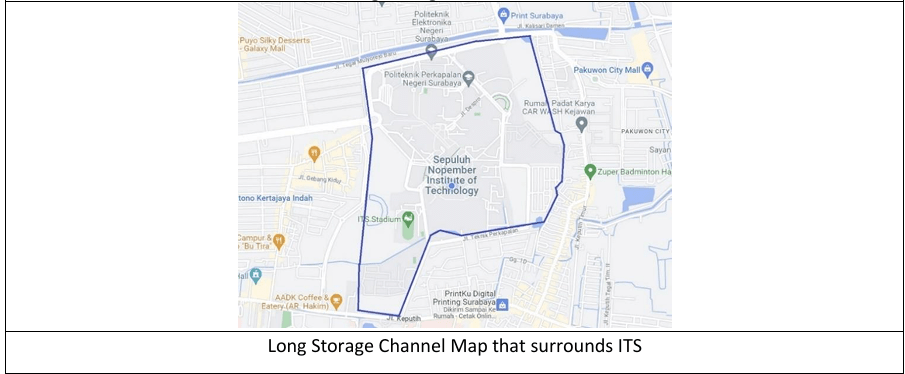
3. Wet Land Area Conservation
ITS has a substantial wetland area, covering approximately 29,6 hectares and constituting about 16% of the campus. These wetlands are actively utilized by the local community for cultivating aquatic plants like water spinach and pandanus. This not only supports local agriculture but also enhances the ecological value of the campus by promoting biodiversity and sustainable land use practices.
4. Installation of Biopore on ITS
ITS has implemented water catchment holes, or biopores, to effectively and efficiently absorb rainwater. These biopores are strategically located in various areas on campus, including the Urban and Regional Planning Department, Mechanical Engineering, Industrial Engineering, UPMB Buildings, SAC, and the Robotika ITS facility. By installing these biopores, ITS enhances groundwater recharge, reduces surface runoff, and promotes sustainable water management practices. This initiative not only helps in mitigating flood risks but also supports the campus’s overall environmental sustainability goals.5. ITS has elevated structure on a building
The elevated structure is designed to preserve the functionality of water recharge areas, allowing rainwater to flow through it. This type of structure can be observed in nearly all buildings at ITS, including those in the Mechanical Engineering, Electrical Engineering, Chemical Engineering, Visual Communication Design, Urban and Regional Planning, and Physics Departments. By incorporating these elevated structures, ITS not only enhances its water management capabilities but also demonstrates a commitment to sustainable building practices. These efforts contribute to reducing surface runoff, mitigating flood risks, and promoting a greener, more resilient campus environment.
6. ITS developed water conservation programs through rainwater harvesting on urban farming ITS
The rainwater harvesting buildings at ITS are ingeniously designed to efficiently collect and store rainwater. This sustainable practice not only conserves water but also plays a crucial role in supporting the development of urban farming initiatives in the open areas across the campus. By utilizing harvested rainwater, these buildings contribute to creating a greener, more self-sufficient environment for the university community.
Wastewater Programs Implementation at ITS
Currently, ITS recycles 30% of its water, which is within the range of >25 – 50% water recycled. ITS has established formal policies for water recycling programs, which include the use of recycled water for various purposes. The specific programs implemented are:
a. Using recycled water from ablution and gray water from the Manarul Ilmi mosque toilets as a resource for fishponds and plant watering,
b. Recycling ablution water to water plants in various departments, including Department of Mechanical Engineering, Industrial Engineering, Marine Engineering, and Material and Metallurgy Engineering,
c. Reutilizing wastewater for toilet flushing at the Research Center, Science Tower, and ITS Rectorate,
d. Optimally utilizing treated gray water from constructed wetlands in the Department of Environmental Engineering These comprehensive programs highlight ITS’s commitment to water conservation and sustainable practices.
By implementing these initiatives, ITS is not only reducing its environmental footprint, but also cultivating a culture of sustainability within the campus community.
1. Using recycled water from ablution and gray water from the Manarul Ilmi mosque toilets as a resource for fishponds and plant watering
Water is recycled through a holding pond and aeration process, allowing it to be reused for watering plants with sprinklers and as raw water for fishponds.
2. Recycling ablution water to water plants in various departments
The water used for ablution in Mechanical Engineering, Industrial Engineering, and Material and Metallurgy Engineering is collected in a holding pond and reused for plant watering.
3. Reutilizing wastewater for toilet flushing at the Research Center
Wastewater from the urinal, sink, and floor drain in the ITS Research Center Buildings’s restroom is treated through a wastewater treatment plant (WWTP) and repurposed for flushing toilets.
4. Reutilizing wastewater for toilet flushing at the ITS Rectorate
Wastewater from the urinal, sink, and floor drain in the ITS Rectorate Buildings’s restroom is treated through a wastewater treatment plant (WWTP) and repurposed for flushing toilets.
5. Optimally utilizing treated gray water from constructed wetlands in the Department of Environmental Engineering
The Environmental Engineering department effectively recycles grey water by collecting it in constructed wetlands. The treated water is then utilized for watering the plants.
ITS’ Multi-Level Water Security Cooperation Initiatives
ITS has demonstrated extensive cooperation in water security through various partnerships at local, regional, and international levels, showcasing effective models of collaboration for sustainable water solutions. Through these multi-faceted partnerships, the institution has created lasting impact across different communities while contributing to global water security discourse.
At the local level, ITS has fostered meaningful community partnerships that have transformed water access in several villages. In Mantren Village, a collaboration with STKIP PGRI Pacitan has successfully provided water access to 70 families, implementing a sustainable system that combines technical expertise with local resources. The project’s success largely stems from the establishment of community maintenance groups (pokmas) that ensure long-term sustainability. Similar success stories have emerged from Tanjungsari Village in Pasuruan, where ITS implemented filtration systems through their Community Service Program (KKN Abmas). In Setrohadi Village, Gresik, the development of water treatment reactors has significantly improved water quality, while in Ngendut Village, Ponorogo, solar-powered water systems have effectively addressed infrastructure challenges.
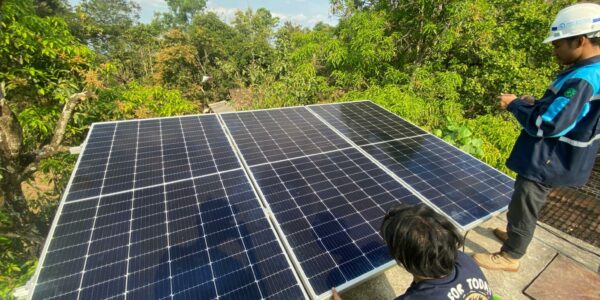
Regional cooperation has been equally impactful, with ITS forming strong partnerships with government entities. A notable collaboration with PDAM Surya Sembada Surabaya has led to the successful implementation of the Master Meters program, benefiting low-income communities. The institution has also worked closely with Gresik authorities to ensure water quality standards through rigorous laboratory testing and compliance measures. These regional efforts have contributed significantly to Surabaya’s impressive 99.9% clean water coverage rate.
On the international front, ITS has engaged actively with global water security initiatives and knowledge exchange programs. The institution’s involvement with the Cycle For Water community has facilitated valuable sharing of experiences and insights across countries. ITS has both learned from and contributed to international best practices, studying successful models like New Zealand’s efficient three water services system while sharing their own innovative local solutions. This international engagement has been particularly valuable in addressing water access disparities between regions and connecting local solutions with global water security challenges.

The technical solutions developed through these partnerships have been both innovative and practical. ITS has successfully created filtration systems using local materials, implemented IoT-enabled solar power solutions, and designed water treatment reactors tailored to specific local conditions. These technical achievements have been complemented by robust community engagement programs, including comprehensive technical training and hygiene education initiatives.
The sustainable impact of these efforts is evident in the improved water access for underserved communities and reduced operational costs through renewable energy solutions. Perhaps most importantly, ITS has created replicable models for water security solutions that can be adapted and implemented in various contexts. The integration of local expertise with international best practices has proven particularly effective in developing sustainable water solutions that are both technically sound and culturally appropriate for the communities they serve.
ITS’ Commitment to Conscious Water Usage on Campus
ITS has implemented an approach to promote conscious water usage across its campus community, combining educational initiatives with technological solutions to create a culture of water conservation. The institution recognizes that sustainable water management requires both behavioral change and infrastructure improvements, leading to a two-pronged strategy that engages all campus stakeholders.
At the heart of this initiative is a campus-wide educational campaign that raises awareness about water conservation among students, staff, and faculty. The campaign emphasizes practical water-saving practices, from taking shorter showers to promptly reporting leaks, and mindful water usage in various campus facilities including laboratories and gardens. These behavioral changes are reinforced through strategic signage and regular communications that remind the campus community of their role in water conservation.
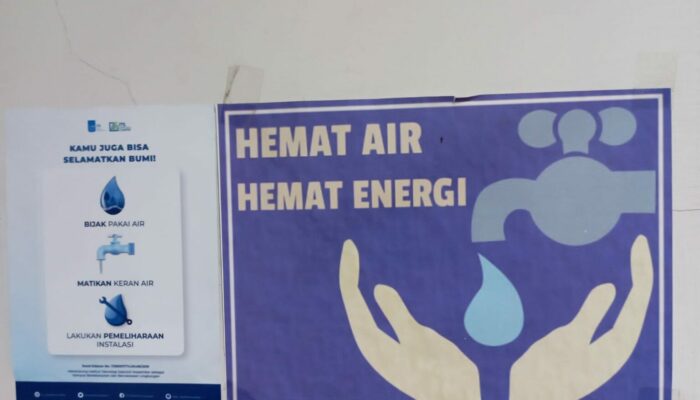
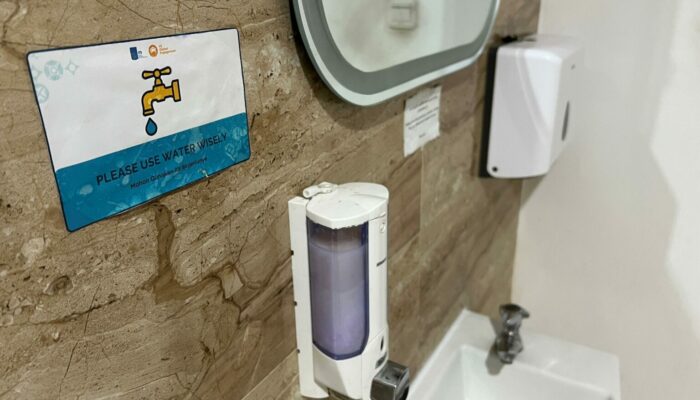
ITS also has made significant investments in water-efficient infrastructure, with more than 30% of installed appliances across campus being water-efficient, exceeding the institutional goal of 20-40% implementation. These technological improvements include:
- Sensor-activated handwashing taps
- Dual flush toilets
- Water-saving showers
- Flow-regulated ablution taps
- Water-efficient sprinklers for campus greenery
The integration of these water-efficient technologies serves a dual purpose: reducing water consumption while also demonstrating practical applications of water conservation principles to the campus community. When students and staff encounter these technologies in their daily routines, it reinforces the importance of water conservation and shows how individual actions contribute to larger sustainability goals.
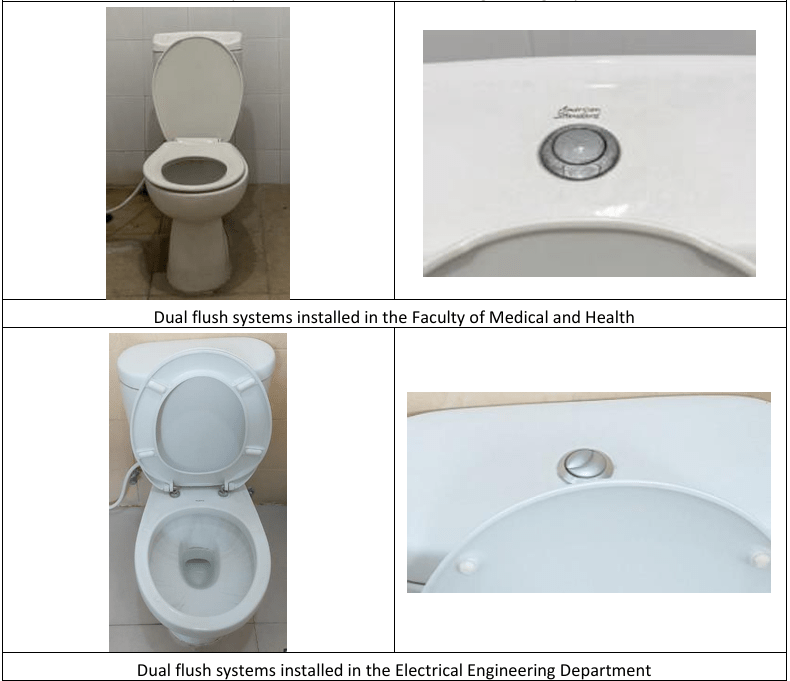
Regular monitoring and maintenance of these systems ensure their optimal performance, with prompt attention to repairs preventing unnecessary water waste. This systematic approach to water management has helped establish water conservation as an integral part of campus culture, making conscious water usage a natural part of daily life at ITS. Through these combined efforts, ITS continues to reduce its environmental impact while fostering a community that values and practices responsible water stewardship.
Promoting Conscious Water Usage: ITS’ Community and International Initiatives
ITS actively promotes conscious water usage in the wider community through a series of innovative programs and collaborations. One such initiative is the Ecotalk Series 6, titled “Environment and Water Awareness,” which included a cycling event with the Cycle For Water community to raise awareness about the importance of water usage. A notable innovation from this series is the Ablution Water Circulation system at the Manarul Ilmi Mosque, which recycles ablution water for plant watering, saving millions of liters over the past decade.
In collaboration with the National Taiwan University of Science and Technology (NTUST), ITS also organized the Engineers in Action (EiA) 2023 program to further promote conscious water usage and enhance environmental quality in Surabaya’s Keputih area. This international platform allows local and international students to collaborate and innovate solutions for local environmental challenges. A key project was the installation of a dripping irrigation system, providing a constant water supply to plants, optimizing growth, and conserving water and nutrients.
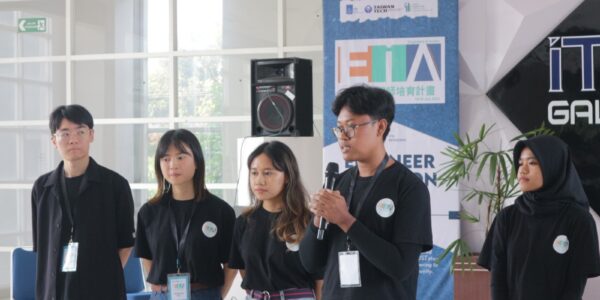
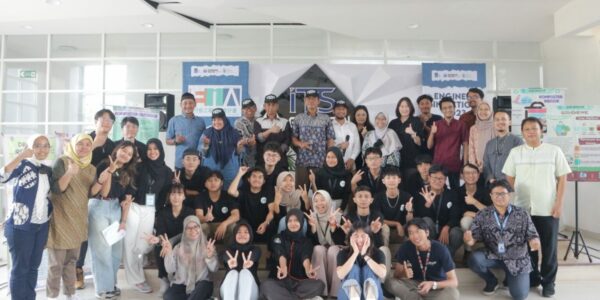
Additionally, the EiA program included the installation of septic tanks for independent waste management and the creation of composters and eco enzymes to encourage sustainable practices. These efforts aim to instill responsibility and awareness about water usage and sustainability among participants and the community.
On an institutional level, PDAM Surabaya’s Master Meters program focuses on providing clean water access to low-income communities, achieving 99.9% clean water coverage in Surabaya. These initiatives emphasize that water is essential for human life and highlight the importance of equal access to clean water and proper sanitation. Overall, ITS’s initiatives underscore the critical need for sustainable water management practices and community engagement.
